The Classification and Mechanism of Microcrack Homogenization Research in Cement Concrete Based on X-ray CT
Abstract
:1. Introduction
1.1. X-ray CT Scanning Technology
- (1)
- Place the core drilling specimen on the turntable;
- (2)
- The X-ray cone beam emitted by the X-ray source irradiates the specimen;
- (3)
- The detector receives X-rays transmitted through the specimen;
- (4)
- After photoelectric conversion and analogue/digital conversion, the input is processed by the computer, and the specimen is scanned 360° by rotating the turntable;
- (5)
- The scanning result is processed with the grey value as the main index, and the two-dimensional and three-dimensional images are obtained through software processing (Figure 1).
1.2. Crack Classification Method
1.3. Statistical Determination of the Number of Cracks
2. Mechanism Analysis
2.1. Statistical Results of the Number of Cracks
2.2. The Mechanism of Crack Generation and Transformation in the Microcrack Homogenization Process
2.3. Analysis of the Cause and Mechanism of Microcracking
2.3.1. Analysis of the Causes of Microcracks
2.3.2. Analysis of Microcracking Mechanism
- (1)
- The principle of minimum energy consumption [28] suggests that any energy-consuming process is carried out by way of minimum energy consumption under its corresponding constraints.
- (2)
- The aggregate particle shape was determined by the distance energy. The distance energy was dissipated along with the aggregate profile. As shown in Figure 11, this distance was shorter for spherical aggregates. For pin-sheet aggregates, the space that the wave travels along the aggregate profile was greater than that directly through the aggregate. Therefore, the energy dissipated by the elastic shock wave along the aggregate outline was greater than the energy of cutting and penetrating the aggregate. The corners of the aggregate surface were weak, so the microcracks cut the aggregate along the edges and corners to form type-II microstructures. Type-III microcracks were formed directly through the aggregate.
- (3)
- Spherical coarse aggregates have a blocking effect on the development of microcracks. The Zaitsev–Wittmann aggregate interference model [35] suggests that the sums have an apparent inhibitory effect on crack propagation. When crack propagation encounters the total, it expands along the aggregate interface until cracking occurs. Because the coarse spherical aggregate generally had greater strength, the plastic strain energy dissipated by microcracks was generally small. Therefore, it was difficult to cause damage to the coarse spherical aggregate.
2.4. Analysis of Cracking Causes and Mechanism
2.4.1. Analysis of Cracking Causes
- Coarse aggregate shape:
- 2.
- Distribution of coarse and fine aggregates:
2.4.2. Analysis of Cracking Mechanism
- (1)
- Similar to microcracks, the interface transition zone is still the weak surface of cement concrete. In addition, the stiffness of concrete is low due to the existence of a large number of microholes and microcracks in the transition zone [36]. In the initial state of cracks, some microcracks first occurred in the transition zone of cement concrete; under the action of alternating load of the falling hammer impact, fatigue damage occurred to the cement–concrete pavement, which further developed microcracks and formed cracks. Therefore, cracks tend to develop along the contour of the coarse aggregate, that is, the interface transition zone.
- (2)
- The influence mechanism of the shape of the coarse aggregate on the cracking law is the same as that of the microcrack, so it will not be repeated here.
- (3)
- The four types of cracks can be attributed to the extremely uneven particle size distribution of aggregates. Large particle size distribution accounts for most of the specimens. As shown in Figure 13, the average particle size of the fine aggregate is 1~2 mm, whereas the particle size of the coarse aggregate marked in the figure reaches 53.6 mm. The difference between the two aggregates is significant. According to analysis of the mesostructure of cement concrete combined with the Mohr–Coulomb principle, first, the embedding effect between coarse and fine aggregates cannot be fully exerted. Secondly, the difference in particle size and spatial distribution of aggregates results in differences in the distribution of cement mortar between aggregates; the coarse aggregates have more voids, so more cement mortar is filled, whereas fine aggregates have less cement mortar, which eventually leads to uneven distribution of the bond strength of cement concrete, and cracks are more likely to occur at weak strengths. In particular, at the point where the fine aggregate gathers, type-IV rupture occurs, which leads to the voiding of the cement concrete slab.
- (4)
- In terms of energy, the plastic strain energy required to generate cracks is much greater than that required to generate microcracks. For the same aggregate particles, the energy dissipated in the generation of microcracks may not be enough to penetrate the aggregate, whereas the energy dissipated in the generation of cracks is larger, so it is more likely to cut and penetrate the aggregate particles. In addition, due to its high plastic strain energy, when passing through the area where the fine aggregates are concentrated, the energy causes the fine aggregates to be fragmented in large quantities to form a local fragmentation phenomenon, that is, type-IV cracking.
3. Conclusions
- (1)
- The statistical results of the number of cracks in the core-drilling specimens show that there were 3582 type-I microcracks, 3197 type-II microcracks, and 1835 type-III microcracks, with an average proportion of microcracks of 47.51%. This result shows that the microcrack homogenization process produced a considerable number of microcracks in the test section and achieved a specific crushing effect. However, there were still macrocracks that cannot be ignored. The reason for this might be the relative randomness of the sampling locations and the differences in the structural conditions of the cement pavement before crushing.
- (2)
- The cracks produced by the microcrack homogenization process can be divided into microcracks and macrocracks. Microcracks occur the initial stage of cracking, with cracking resulting from the further development of microcracks. The development laws of the two are similar. Both developed easily along the transition zone of the aggregate–cement mortar interface. However, the energy dissipated by cracking was enormous, and the probability of cutting and penetrating the aggregate was high.
- (3)
- Uneven particle size distribution and needle-like shape of aggregate were the main reasons for cracking. Generating more microcracks and suppressing cracking could achieve a better effect of the microcrack homogenization process. The following measures could be taken in the cement concrete mixture ratio design stage. First, the particle size and ratio of coarse and fine aggregates should be reasonably designed to form a more uniform spatial distribution structure of the aggregates. Secondly, smooth, round aggregates should be used, and the content of needle flake aggregates should be controlled.
- (4)
- To promote the further development of the microcrack homogenization process, it was necessary to achieve refinement at the construction execution level according to the differentiation of the structural conditions of the cement pavement before crushing. First of all, construction personnel should strengthen the preinspection of the original pavement structure before microcrack treatment, such as by using traditional deflection detection or intelligent non-destructive testing methods to detect existing cracks and voids and other diseases in cement concrete pavement. Secondly, for these original “weak areas” of the pavement structure, the initial position of the drop hammer impact can be lowered, and the drop hammer gear can be reduced to achieve refinement.
Author Contributions
Funding
Institutional Review Board Statement
Informed Consent Statement
Data Availability Statement
Conflicts of Interest
References
- Shu, Q. Brief Analysis on Reconstruction Technology of Cement Concrete Pavement from White to Black. J. Highw. Transp. Res. Dev. 2014, 10, 69–70+82. [Google Scholar]
- Wang, J. Analysis the Control techniques of reflection crack on asphalt overlay of old cement concrete pavement. In Proceedings of the International Conference on Civil, Architectural and Hydraulic Engineering (ICCAHE 2012), Zhangjiajie, China, 10–12 August 2012. [Google Scholar] [CrossRef]
- Pan, S. Application of Resonance Crushing Technology in Cement Concrete Pavement Reconstruction. Transp. World 2022, 11, 73–74. [Google Scholar] [CrossRef]
- Wu, C.; Yuan, J.; Deng, J. On-site crushing and regeneration evaluation of old cement concrete pavement and application of HHT-3 fracturing and compression stabilization. In Proceedings of the 6th China Highway Science and Technology Innovation High-Level Forum (Volume 1), Beijing, China, 17–18 April 2013; pp. 118–123. [Google Scholar]
- Qiu, S. Application of fracturing and stabilizing technology in pavement “white to black” project. Fujian Jiaotong Keji 2019, 5, 35–37. [Google Scholar]
- Li, H.; Yu, H.; Wu, C. Engineering Application of Microcrack Homogenization Treatment and Regeneration Technology for Cement Pavement. In Proceedings of the 8th Annual Academic Conference of Maintenance and Management Branch of China Highway Society, Xiamen, China, 18–19 January 2018; pp. 289–297. [Google Scholar]
- Wu, C.; Fang, D.; Zhang, P. Application of Micro-Crack Regeneration Grouting Reinforcement Technology in the Reconstruction of Old Cement Concrete Pavement; Fujian Jiaotong Keji: Fuzhou, China, 2017; pp. 2–9. [Google Scholar]
- Song, Y. Application effect analysis of micro-crack homogenization treatment of old cement pavement in Hengnan section of National Highway 322 in Hengyang City. Constr. Mater. Decor. 2019, 24, 268–269. [Google Scholar]
- Wang, D. Micro-Crack Homogenization Treatment and Regeneration Technology for Cement Concrete Pavement. Ph.D. Thesis, Chang’an University, Xi’an, China, 2019. [Google Scholar] [CrossRef]
- Zhao, M. Mechanism of Cement Pavement Microcrack Homogenization under Impact of Falling Weight. Ph.D. Thesis, Chang’an University, Xi’an, China, 2021. [Google Scholar] [CrossRef]
- Meng, K.; Liang, B.; Liu, J.; Yan, F. Review on application research of micro computed tomography in the concrete performance analysis in microfocus industry. Miner. Resour. Geol. 2020, 34, 396–400. [Google Scholar] [CrossRef]
- Morgan, I.L.; Ellinger, H.; Klinksiek, R.; Thompson, J.N. Examination of concrete by computerized tomography. J. Am. Concr. Inst. 1980, 77, 23–27. [Google Scholar]
- Lawler, J.S.; Keane, D.T.; Shah, S.P. Measuring three-dimensional damage in concrete under compression. ACI Mater. J. 2001, 98, 465–475. [Google Scholar] [CrossRef]
- Suzuki, T.; Ogata, H.; Takada, R.; Aoki, M.; Ohtsu, M. Use of acoustic emission and X-ray computed tomography for damage evaluation of freeze-thawed concrete. Constr. Build. Mater. 2010, 24, 2347–2352. [Google Scholar] [CrossRef]
- Tian, W.; Dang, F.; Liang, X. CT analysis on dynamic meso-fracture process of concrete based on the image processing. J. Hydroelectr. Power Gener. 2009, 28, 147–151. [Google Scholar]
- Zhou, S.; Liu, J.; Li, B.; Zhang, S.; Liu, T. Numerical Simulation Study of Concrete Microscopic Damage Based on CT Image. China Concr. Cem. Prod. 2022, 29–32. [Google Scholar] [CrossRef]
- Fan, W.; Liu, F.; Xu, J.; Hu, G.; Wang, W.; Wang, Y.; Cheng, W.; Zhou, P.; Sun, H.; Xia, T. Research on Digital Control of Asphalt Pavement Construction Quality Based on CT Technology. Jiangxi Expressway Investment Group Co., Ltd.; Nanchang Engineering College; Jiangxi Transportation Consulting Company; Jiangxi Ex-pressway Investment Group Fuzhou-Jian Expressway Project Construction Office. 2012-01~2015-08. Available online: https://kns.cnki.net/KCMS/detail/detail.aspx?dbname=SNAD&filename=SNAD000001671025.2016 (accessed on 25 April 2022).
- Li, S.; Zhang, H.; Fang, S.; Ma, Y.; Chen, S. Application of CT scan in pavement overlay structure. J. Chang. Univ. Sci. Technol. 2020, 17, 1–6. [Google Scholar]
- Griffith, A.A. The Phenomena of Rupture and Flow in Solids. Philos. Trans. R. Soc. A 1920, A221, 163–198. [Google Scholar] [CrossRef] [Green Version]
- Kaplan, M.F. Crack Propagation and the Fracture of Concrete. J. Proc. 1961, 591–610. [Google Scholar]
- Jenq, Y.; Shah, S.P. A Fracture toughness criterion for concrete. Eng. Fract. Mech. 1985, 21, 1055–1069. [Google Scholar] [CrossRef]
- Jenq, Y.; Shah, S.P. Two Parameter Fracture Model for Concrete. J. Eng. Mech. 1985, 111, 1227–1241. [Google Scholar] [CrossRef]
- Bažant, Z.P.; Oh, B.H. Crack Band Theory for Fracture of Concrete. Mater. Struct. 1983, 16, 155–177. [Google Scholar] [CrossRef] [Green Version]
- Hillerborg, A.; Modéer, M.; Petersson, P.E. Analysis of crack formation and crack growth in concrete by means of fracture. Cem. Concr. Res. 1976, 6, 773–782. [Google Scholar] [CrossRef]
- Dougill, J.W.; Bažant, Z.P. Constitutive relations for concrete and rock: Applications and extensions of elasticity and plasticity theory. In Mechanics of Geomaterials: Rocks, Concrete, Soils; Dougill, J.W., Ed.; John Wiley & Sons: Chichester, UK, 1985; pp. 21–46, (papers to the IUTAM William Prager Symposium, Evanston, 11–15 Sept 1983) P2. International Journal of Rock Mechanics and Mining Sciences & Geomechanics Abstracts, 1986, 23, 175; Available online: https://www.researchgate.net/publication/282992304_constitutive_relations_for_concrete_and_rock_applications_and_extensions_of_elasticity_and_plasticity_theory (accessed on 25 April 2022).
- Krajcinovic, D. Constitutive Equations for Damaging Materials. J. Appl. Mech. 1983, 50, 355. [Google Scholar] [CrossRef]
- Li, J. Research on the Stochastic Damage Mechanics for Concrete Materials and Structures. J. Tongji Univ. Nat. Sci. 2004, 32, 1270–1277. [Google Scholar]
- Zhou, Z. Principle of least rate of energy consumption and some application of its in solid mechanics. Nat. Sci. J. Xiangtan Univ. 1993, 41–47. [Google Scholar]
- Tang, S.; Luo, Y.; Zhou, Z. Establishing the damage developing equation of concrete through the principle of minimum dissipation of energy. J. Jinan Univ. Nat. Sci. Med. Ed. 2005, 26, 69–71. [Google Scholar]
- Wang, H. Study on Elastic-Plastic Constitutive Based on the Least Energy Dissipation Principle and Numerical Simulation of Crack Propagation. Ph.D. Thesis, Jinan University, Guangzhou, China, 2012. [Google Scholar]
- Wittmann, F. Fracture toughness and fracture energy of concrete. In Proceedings of the International Conference on Fracture Mechanics of Concrete, Lausanne, Switzerland, 1–3 October 1985. [Google Scholar]
- Zampini, D.; Shah, S.P.; Jennings, H.M. Early age microstructure of the paste-aggregate interface and its evolution. J. Mater. Res. 1998, 13, 1888–1898. [Google Scholar] [CrossRef]
- Yao, C. Fatigue Damage and Life Prediction of Concrete. Ph.D. Thesis, Harbin Institute of Technology, Harbin, China, 2010. Available online: http://lib.xbmu.edu.cn/asset/detail/0/20429075326.2010 (accessed on 25 April 2022).
- Mei Tai, P.K. Structure, Properties and Materials of Concrete, Tongji University Press: Shanghai, China, 1991.
- Li, Z. Damage Mechanics and Its Applications, 2002. Available online: https://book.sciencereading.cn/shop/book/Booksimple/show.do?id=B3CF6C62B01D7412C9A8E598BCAE24752000 (accessed on 25 April 2022).
- Shang, Y. Numerical Simulation of Static and Dynamic Mechanics Performance of Mas Concrete. Ph.D. Thesis, Hohai University, Nanjing, China, 2004. [Google Scholar]
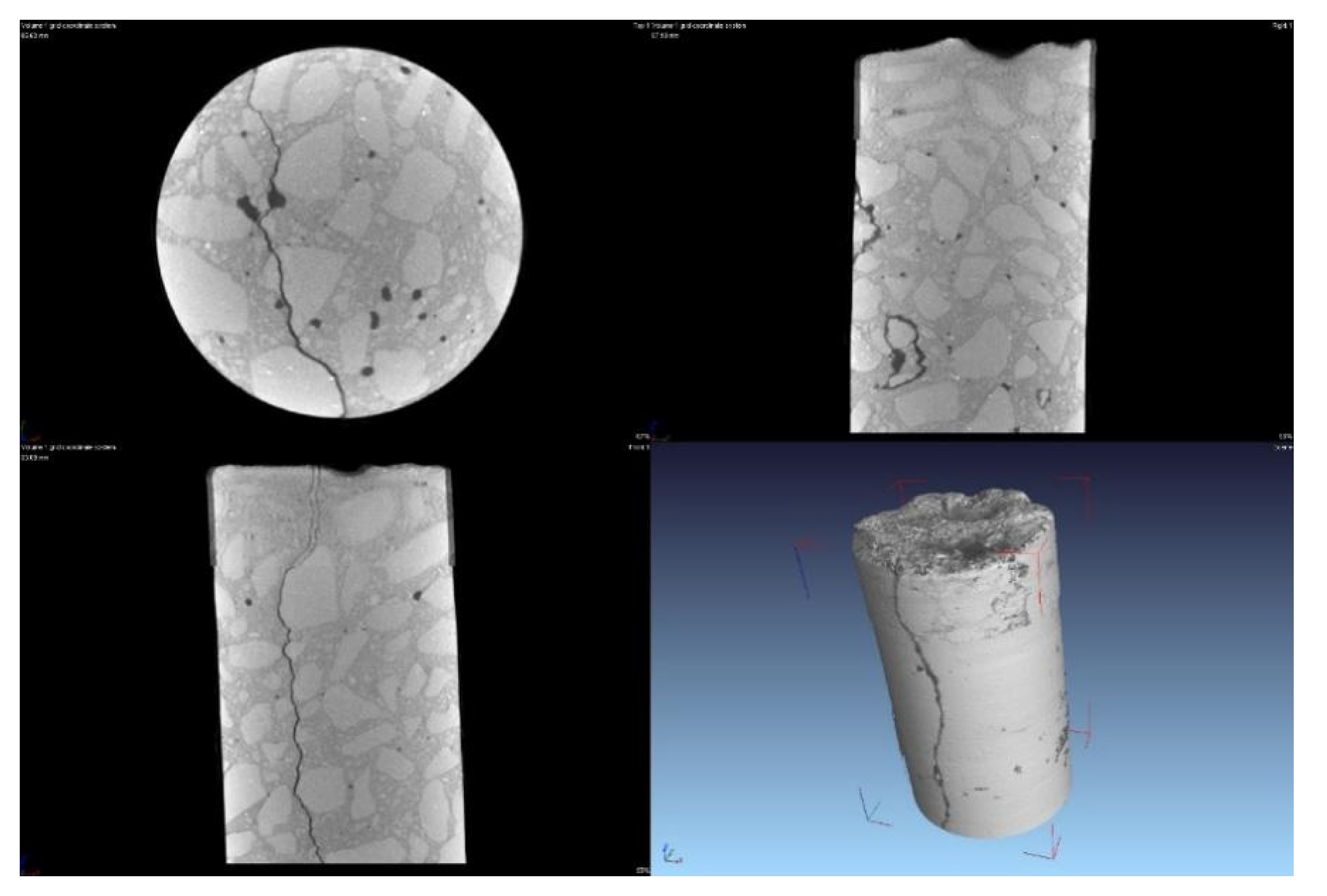



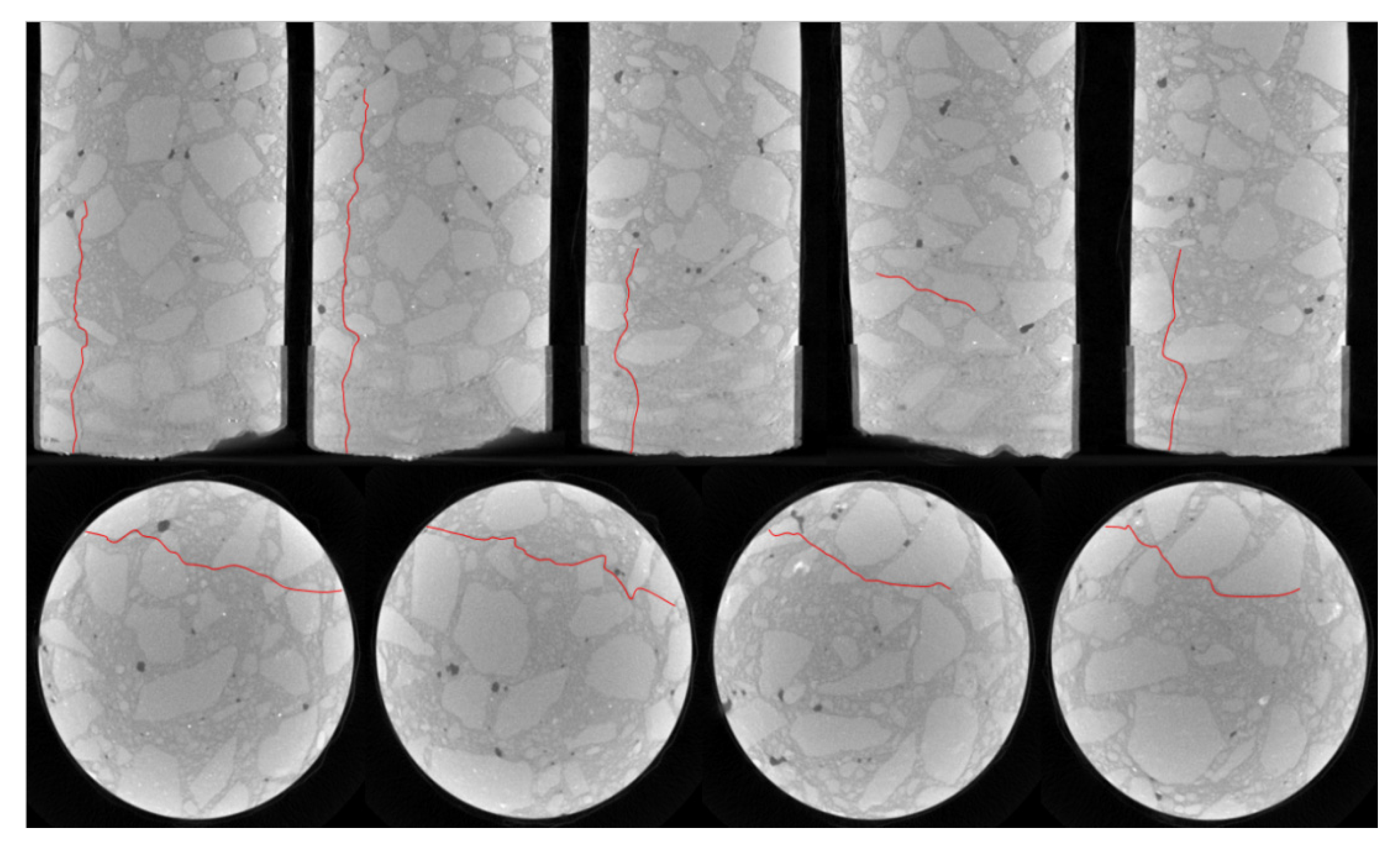
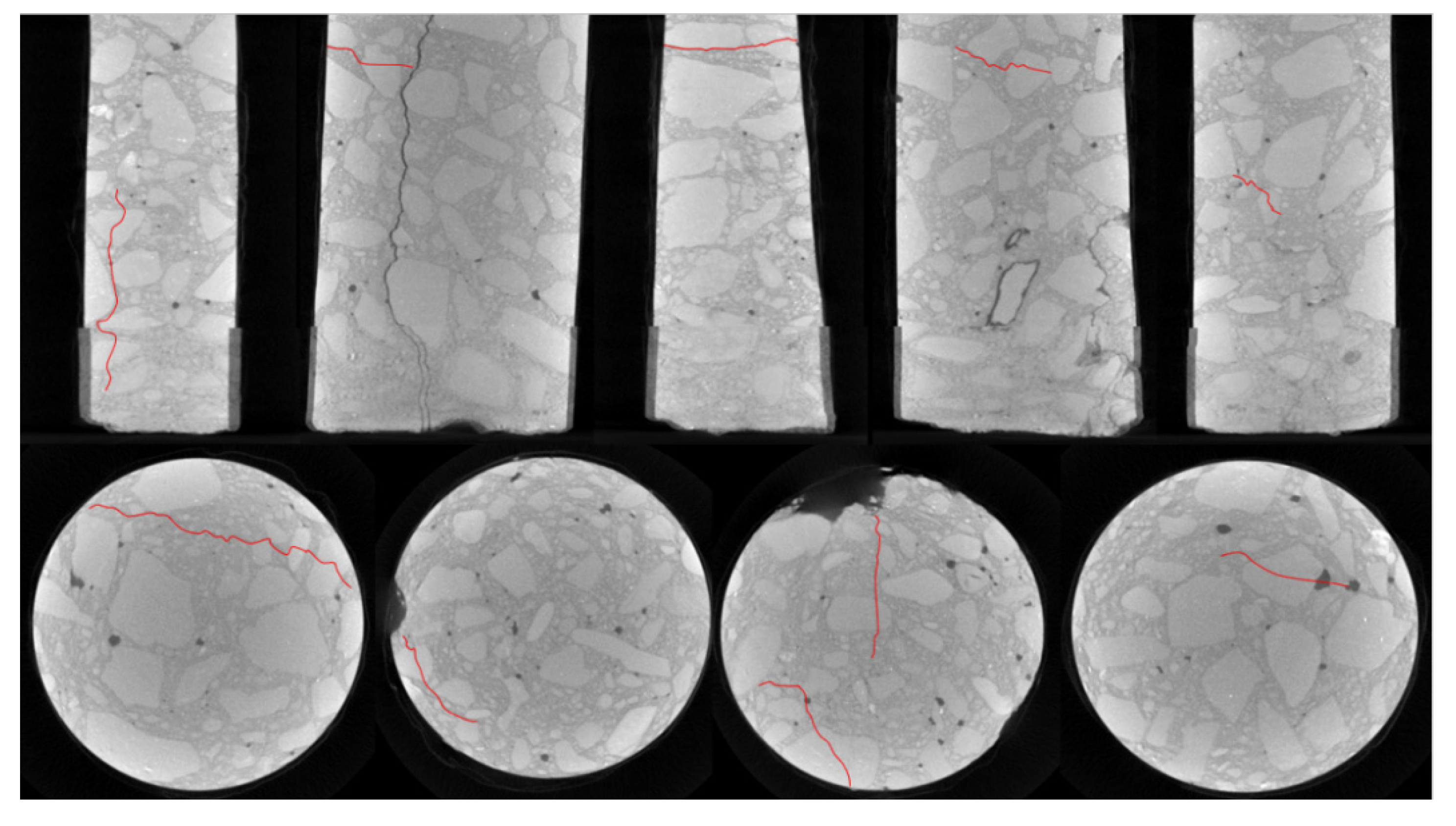
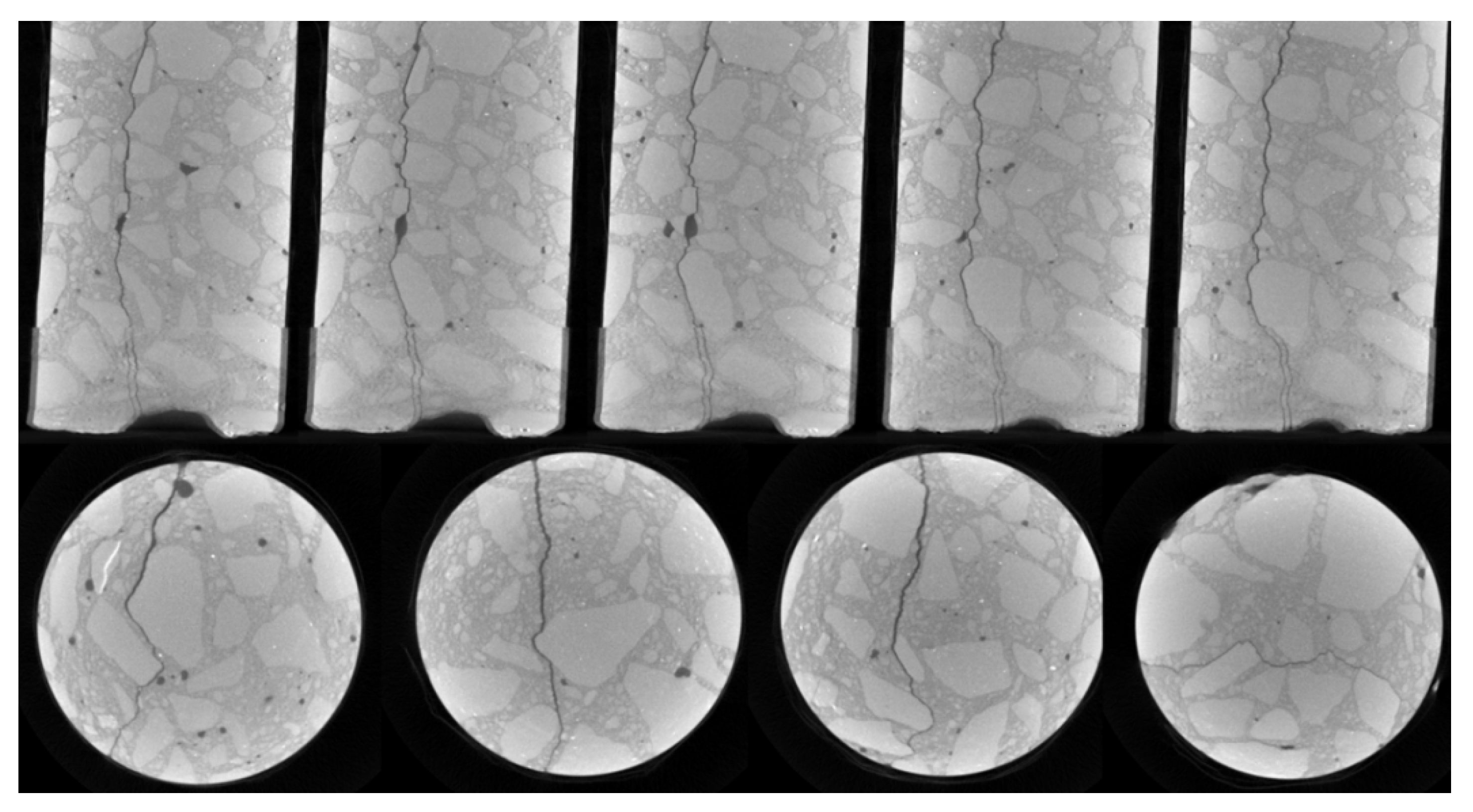
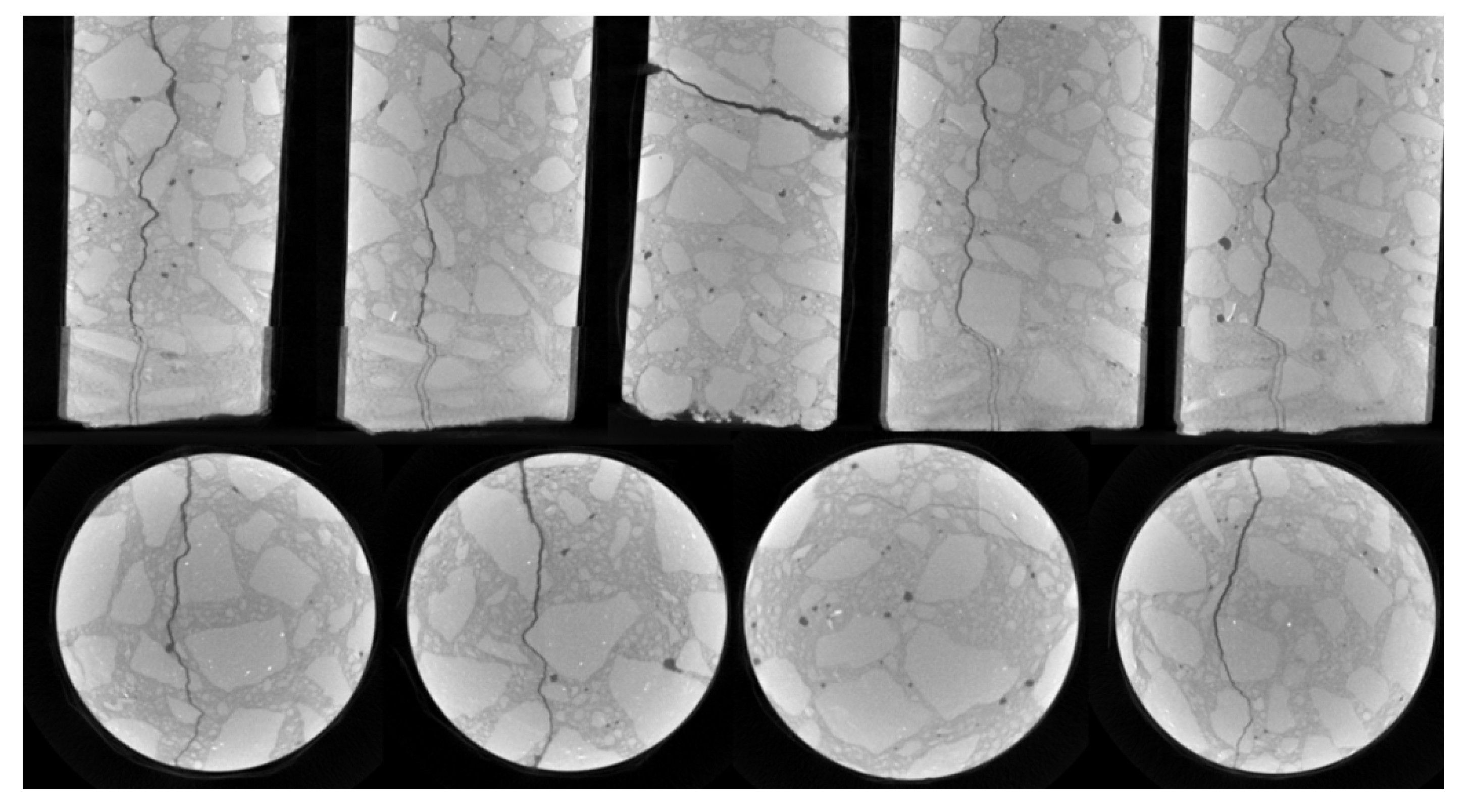
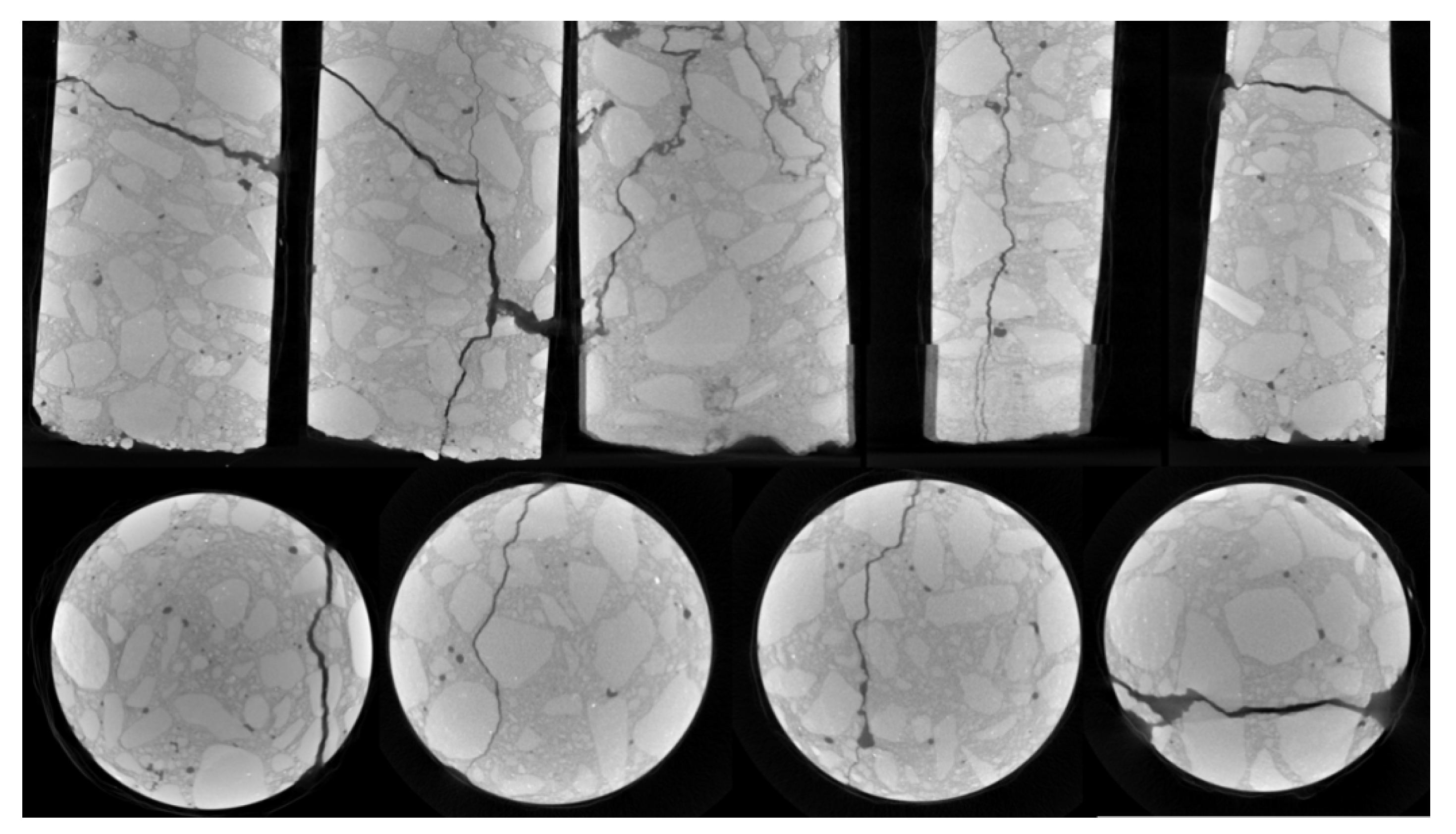
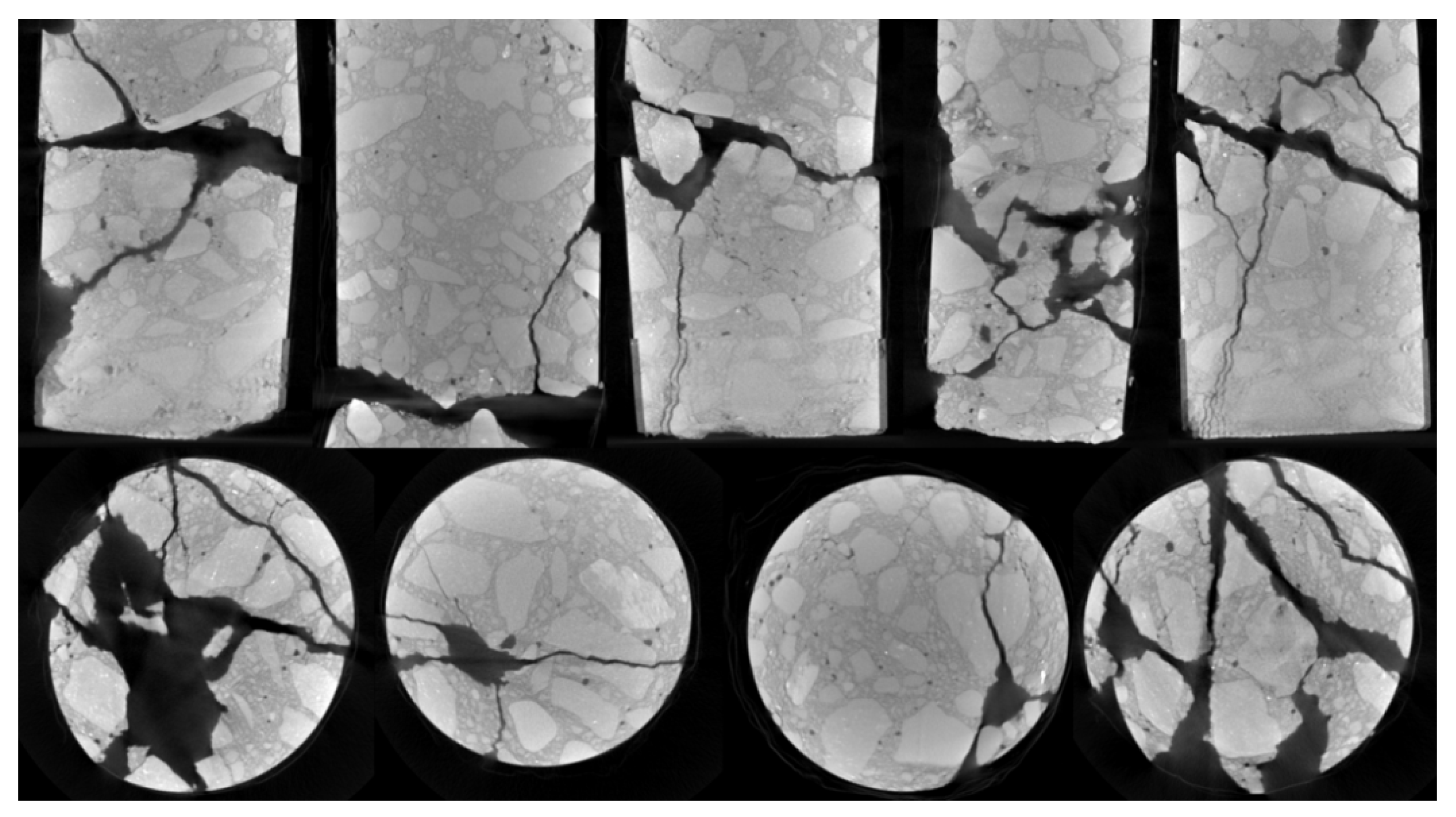


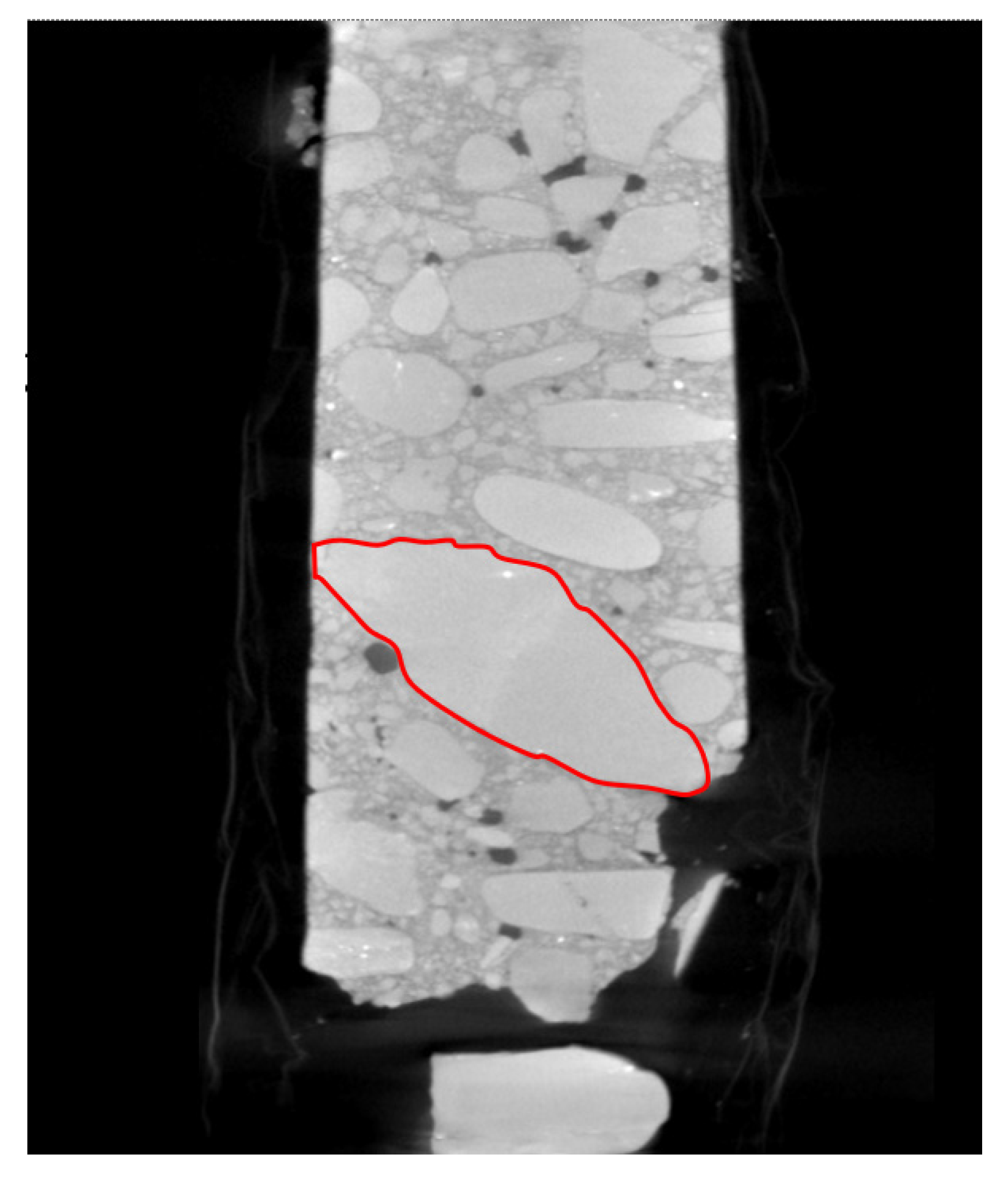
| Type | Characteristics |
|---|---|
| Type-I microcrack | The cracks developed completely along the outline of the coarse aggregates. |
| Type-II microcrack | The cracks developed along the outline of the coarse aggregates, but there was a phenomenon whereby the bangs cut through the corners of the coarse aggregates. |
| Type-III microcrack | The cracks developed along the outline of the coarse aggregates, but there was a phenomenon whereby the crack cut through the center of the coarse aggregates. |
| Type-I crack | The development direction of the crack was entirely along the outline of the coarse aggregates, and the cracks were relatively slender. |
| Type-II crack | The development direction of the cracks was basically along the outline of the coarse aggregate, but there was a phenomenon whereby the cracks cut through the corner of the coarse aggregate, and the cracks were relatively slender. |
| Type-III crack | The development direction of the cracks was not completely along the outline of the coarse aggregates; the cracks directly cut through the center of the coarse aggregate, and the cracks were thicker. |
| Type-IV crack | The crack development followed the outline of the coarse aggregates, causing fragmentation in the area where the fine aggregates gathered. The fragmentation was strip-shaped or block-shaped to a large extent. |
| Project Road Section Number | CT Slice Images (Sheets) | Type-I Microcracks (Strips) | Type-II Microcracks (Strips) | Type-III Microcracks (Strips) | Type-I Cracks (Strips) | Type-II Cracks (Strips) | Type-III Cracks (Strips) | Type-IV Cracks (Strips) | Microcrack Ratio (%) |
|---|---|---|---|---|---|---|---|---|---|
| K4+950−1 | 841 | 517 | 640 | 323 | 170 | 20 | 428 | 841 | 50.36 |
| K4+950−2 | 861 | 584 | 369 | 275 | 647 | 452 | 548 | 861 | 32.87 |
| K5+000 | 795 | 676 | 399 | 227 | 844 | 357 | 469 | 795 | 34.56 |
| K6+000 | 772 | 218 | 146 | 24 | 0 | 0 | 0 | 0 | 100.00 |
| K8+100 | 784 | 578 | 683 | 396 | 589 | 214 | 134 | 0 | 63.88 |
| K8+200 | 769 | 324 | 448 | 165 | 213 | 285 | 106 | 0 | 60.80 |
| K8+300 | 829 | 685 | 512 | 425 | 459 | 387 | 327 | 371 | 51.23 |
| Total | 5651 | 3582 | 3197 | 1835 | 2922 | 1715 | 2012 | 2868 | 47.51 |
Publisher’s Note: MDPI stays neutral with regard to jurisdictional claims in published maps and institutional affiliations. |
© 2022 by the authors. Licensee MDPI, Basel, Switzerland. This article is an open access article distributed under the terms and conditions of the Creative Commons Attribution (CC BY) license (https://creativecommons.org/licenses/by/4.0/).
Share and Cite
Wang, R.; Wu, H.; Zhao, M.; Liu, Y.; Chen, C. The Classification and Mechanism of Microcrack Homogenization Research in Cement Concrete Based on X-ray CT. Buildings 2022, 12, 1011. https://doi.org/10.3390/buildings12071011
Wang R, Wu H, Zhao M, Liu Y, Chen C. The Classification and Mechanism of Microcrack Homogenization Research in Cement Concrete Based on X-ray CT. Buildings. 2022; 12(7):1011. https://doi.org/10.3390/buildings12071011
Chicago/Turabian StyleWang, Rui, Hongjuan Wu, Mohan Zhao, Yu Liu, and Chengqin Chen. 2022. "The Classification and Mechanism of Microcrack Homogenization Research in Cement Concrete Based on X-ray CT" Buildings 12, no. 7: 1011. https://doi.org/10.3390/buildings12071011





